A place to spend the day at the beach with crystalline waters and white sand, somewhere to swim or practice water sports and enjoy a concert or cultural event in a gastronomic and commercial setting. Uruguay’s leading newspaper, El País, has announced that Public Access Lagoons™, or PAL™, can offer all of this without leaving the city. This business model created by Crystal Lagoons®, the multinational that creates crystalline man-made lagoons in urban environments, is set to land in Uruguay in 2021.
The company’s first development in the country was a holiday resort complex known as Solanas, located in Maldonado, but operates privately, not as a PAL. Public Access Lagoons, on the other hand, grant the general public access via ticketed entry and offer a day at the beach and use of all the amenities available, said Jean Pierre Juanchich, Crystals Lagoons Regional Director for Latin America.
This new business model was launched in October last year and already represents 90% of the company’s turnover, he added. “Since then, we have already signed contracts for 130 PAL,” he said.
The plan is developed in three phases. The first, which requires an investment of approximately US$ 8 million, is anchored by a lagoon, a beach, green areas with kiosks and basic services such as bathrooms. It can be built in one year and, judging from past experiences, the investment is recovered in one or two years, confirmed Juanchich.
The second stage includes services around the lagoon, such as a wedding peninsula (an event center for weddings overlooking the lagoon), an area for concerts, road shows, restaurants and retail stores. This phase involves an additional US$ 7 million and is finalized in two years once the PAL is operational.
Finally, the more complex plan includes the construction of a hotel overlooking the beach and is considered an opportunity rather than a necessity for the model to succeed.
Jean Pierre Juanchich stated that, in general, each project spans over about 25 acres and usually include a 5-acre lagoon. The income generated during the first phase kick starts the investment for the second phase. “In one or two years the investment is recovered, because it requires low maintenance.”
The company estimates a ticket to cost US$ 10 and, according to studies carried out in the country, each lagoon would receive an influx of between 500,000 and 800,000 people per year. “Their proximity to Argentina is key,” he added. In any case, the main income is provided by other businesses, such as restaurants, retail, event centers, weddings, food trucks and brand sponsorship on the beaches. “With the three phases in operation, ticket revenues make up just 20% of the total.”
Negotiations in Uruguay are already underway with investment funds moving forward. At the moment, the negotiations have advanced quickly so as to start building between three or four PAL in Uruguay that would include hotels. “We license exclusive agreements with each country and are in advanced conversations to roll out between four and six projects in Uruguay. The negotiations are most advanced in cities such as Montevideo (which may include two), Paysandú and Carmelo, but Punta del Este is also on the map”.
The plan is to start building the first lagoon in 2021, so it is operational in 2022.
Private projects
Additional to the PAL, the company will continue with its private use lagoons in real estate projects and Juanchich expects as many as five such amenities in Uruguay (including Solanas).
Unlike Solanas, those that follow will anchor residential housing projects. One will be in Montevideo’s Carrasco neighborhood, in Colinas de Carrasco II. The design and details are still being studied and will be defined at a later date. The second will be in José Ignacio (Maldonado) in an area for holiday homes, and is currently being studied, he added.







